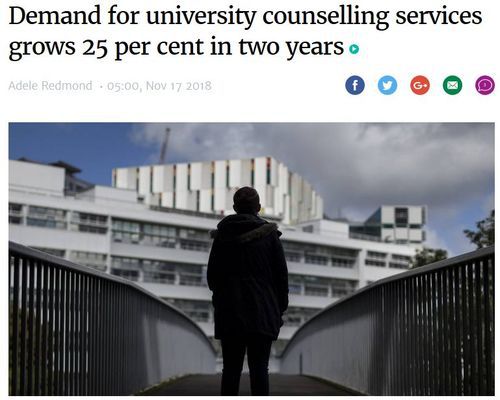


11/19/2018
One of the questions that I brought up in my review of Jonathan Haidt and Greg Lukianoff’s The Coddling of the American Mind was whether the usual high degree of unhappiness found on college campuses is getting worse. This could just be random noise, but here’s an article from New Zealand finding a similar trend:
Demand for university counselling services grows 25 per cent in two years
Adele Redmond 05:00, Nov 17 2018
More than half of students who responded to a recent NZUSA mental health survey said they had considered dropping out. University students say they are on suicide watch for friends and flatmates as demand for on-campus counselling grows.
One in 13 university students — 13,000 in total — accessed campus counselling services last year, nearly a 25 per cent increase on the 10,500 who used the services in 2015, according to data released to the New Zealand Union of Students’ Associations (NZUSA) by all universities except Lincoln.
Haidt and Lukianoff point to Jean Twenge’s recent book iGen. She looks at a lot of American data, such as the General Social Survey, and surmises that people born from about 1995 onward, who went through junior high school and high school with social media on smartphones, are not on average in good shape emotionally.
In general, research universities have not been very enthusiastic about researching the topic of psychological damage that universities might be doing to young people.
I’m a big fan of social science but over the decades I’ve seen very little social science done by universities on close-at-hand topics such as what kind of living arrangements are most conducive to the flourishing of college students. For example, I went to college at Rice U., which has a “college” system of dormitories where you stay in the same dorm for four years. And each dorm has its own dining hall, with family-style meals at set times. (I believe some Ivy League colleges has similar arrangements.)
The downside is that the food was cooked in a central kitchen and trucked around to the dorms’ dining halls, so it was pretty dismal by the time it arrived. Also, you didn’t get any choice, you just got whatever was being served. The upside is that you have a relatively stable community of about 250 people that you eat and live with for a year, and next year, 75% of the same people are back. It’s like a giant fraternity house, except you are assigned to a “college” largely at random.
Is that a better system psychologically, less anomie-inducing, than the more conventional dorm and dining hall set-up?
I don’t know. It would seem like an interesting question for a research university to research, but if that research is ever done, I haven’t heard about it.